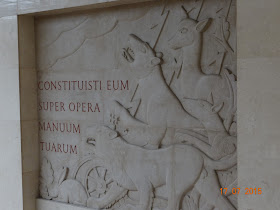And from the Human Rights and Alliance of Civilizations Room, we continued on the original section of the Palais, the one constructed in the 1920s...
A view of the main building, Building A...
The passageway leading into Building A...
Another artwork...
Hanuk leading the way...
Patek Philippe is the official timekeeper of the UN!
A view of the Armillary Sphere in the Arianna Park. More on the Sphere:
This gold-plated bronze sphere is the symbol of the UN Office at Geneva. It illustrates the different constellations of the universe: its 65 constellations are gold-plated and its 840 stars are silvered, reflecting the world’s cultures existing in harmony.It is the centrepiece of the Cour d’Honneur, south-east of the Salle des Pas Perdus.Also known as The Celestial Sphere, it was designed by the American sculptor Paul Manship, then cast and plated in Italy by Bruno Bearzy.In its early years, the sphere would slowly rotate. But its prolonged exposure to the elements has damaged the internal motor – and any attempts to repair it would mean completely disassembling an original masterpiece of art deco sculpture.It was donated in 1939 by the Woodrow Wilson Foundation to commemorate the US President’s work for the creation of the League of Nations.
(Source: United Nations Office at Geneva website http://www.unog.ch/virtual_tour/palais_des_nations.html)
The Conquest of Space monument. More on the imposing monument:
This two-part monument, a gift from the former Union of Soviet Socialist Republics, is dedicated to human success in the conquest of space.The slender, arrow-shaped plinth is 28 metres high and formed from Ukrainian stone covered with a thin layer of titanium (the heat-resistant element used to protect spacecraft).A few metres away, the bronze statue of a cosmonaut in a spacesuit with arms reaching to the skies symbolises mankind’s wish to explore outer space.The work’s major creator was the Russian sculptor Youri Neroda, who was unable to attend the monument’s inauguration in 1971 because of the tragic deaths of three Russian cosmonauts.
(Source: United Nations Office at Geneva website http://www.unog.ch/virtual_tour/palais_des_nations.html)
Unfortunately the statue of the cosmonaut isn't visible from up here and access to grounds is prohibited!
Members of our group passing through the Salle des Pas Perdus...
More artwork, these ones in the Salle des Pas Perdus...
That's Lake Geneva in the distance...
What a stately building...
Meetings in progress...
A vase shaped like a globe...
A porcelain vase (The Blue Planet of Life) by Yasuhiko Shirakata, given by Japan to mark the UN’s 50 th anniversary in 1995. The vase, deep indigo blue on a white enamelled base, symbolises a world living in peace and respecting the environment.
Shirakata, born in Tobe, a town famous for it pottery and ceramics for more than 200 years, involved schoolchildren in the concept and design of the vase, which is two metres high, including its stand.
(Source: United Nations Office at Geneva website http://www.unog.ch/virtual_tour/palais_des_nations.html)
Passing by the Lobby of the Council Chamber...
The Lobby’s largest feature is a massive and evocative bas-relief in marble above the main entrance to the Chamber entitled The Creation of Man. The work is by the English sculptor Eric Gill and was donated to the League of Nations by the United Kingdom in 1938. The sculpture is a triptych, with the central panel (2.3m x 9.28m) being inspired by Michelangelo’s Sistine Chapel fresco. The left panel shows Man’s Gifts to God, the right panel shows God’s Gifts to Man.
(Source: United Nations Office at Geneva website http://www.unog.ch/virtual_tour/palais_des_nations.html)






















No comments:
Post a Comment